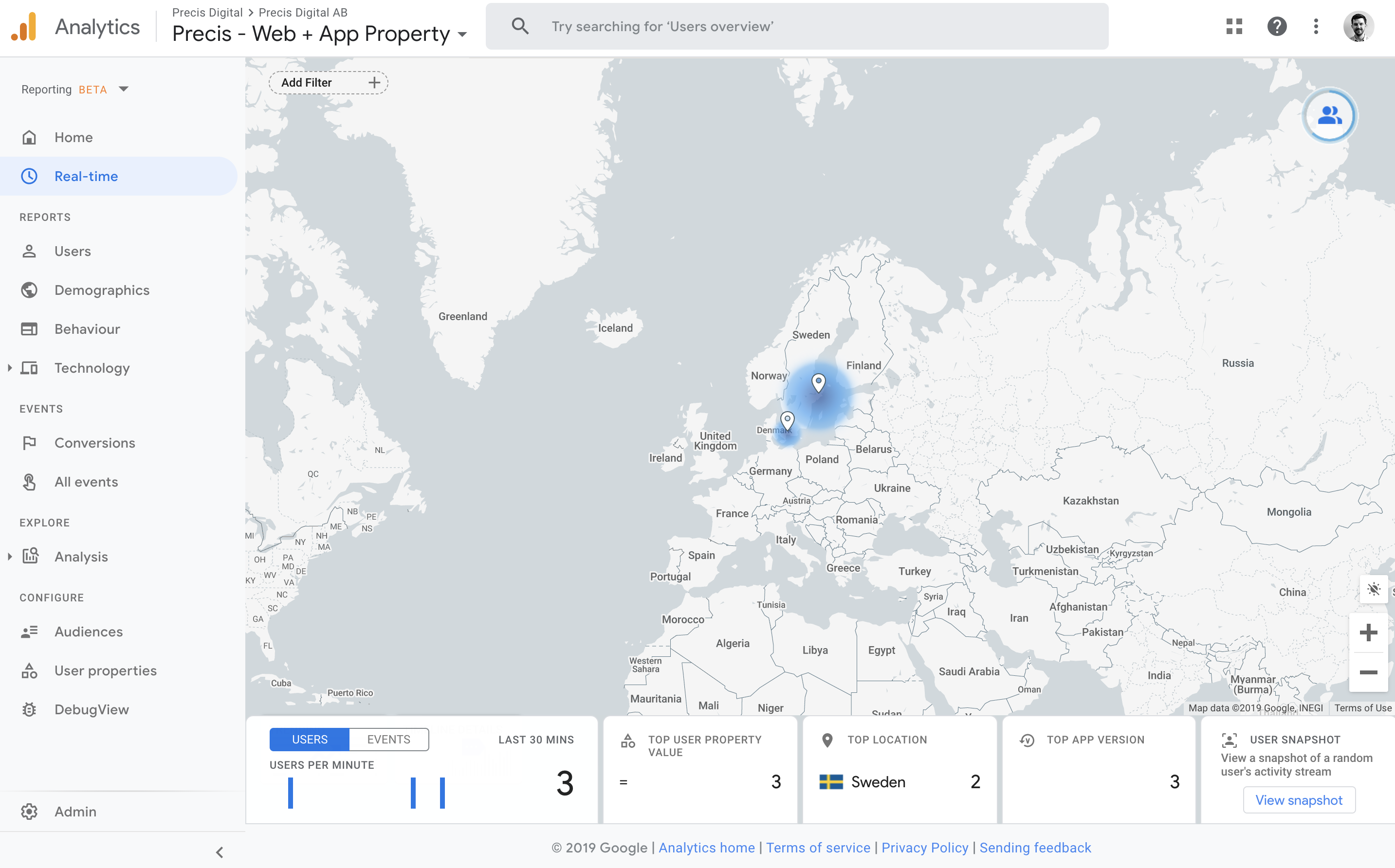App + web properties

Rhys Cater
CEO Precis London
This month marks the announcement of a major step forward for Google Analytics. In a blog post, Google detailed the launch of App + Web Properties – a from the ground-up rebuild of how the platform works.
A first look at the next generation of digital analytics from Google
Google Analytics for Apps has always felt like a second class citizen, forcing users to collect and analyse data from apps through the lens of a web-centric tool. Even as more useful app-first features were launched, the underlying design of the platform remained a fundamental limitation.
Drastic action was needed to keep up with the mobile-first world, and so in 2016 Google launched Firebase Analytics – an analytics platform designed and built with mobile at heart. With it, Firebase brought a brand new data model, expanded limits for data collection, and extensive integrations for the app ecosystem.
As well as being a big step forward for app analytics, Firebase Analytics opened people’s eyes to the fact that Google Analytics’ data model for web had begun to feel outdated. Why are we forced to use fields named “Event Category”, “Event Action”, and “Event Label” to store variables from different interactions that are completely unrelated? It turns out that the new structures for collecting and storing data designed for Firebase could have a positive impact on the whole platform.
Why we are excited
There are a few reasons we’re excited for the launch of App+Web Properties and what it holds for the future of digital analytics.
Unified Data Model
The latest version of Google Analytics offers a data schema that feels much more modern, comprehensible, and consistent between platforms.
In the new model, all user interactions are collected using an Event Name accompanied by parameters set in key-value pairs. This schema can be suitable for many types of businesses and more importantly reduces the dependence on a knowledge of the specific workings of Google Analytics in order to manipulate and analyse the data. The lives of Data Scientists and analytics teams everywhere are about to get easier!
App + Web properties also introduce Enhanced Measurement, a feature that enables the automatic collection of common user interactions in a consistent way to reduce implementation overhead.
New Reports
Google is making Advanced Analysis, previously a GA360 feature, available to all App + Web users. This includes:
Funnel Reports: One of the most exciting releases! Funnels finally bring Google Analytics up to date and allow for more flexible analysis of user journeys through a predefined sequence of steps (including pageviews, events, and custom parameters!)
Path analysis: Visualise the most common user journeys from a given starting point in an interface that is clearer and easier to navigate than the legacy path reports in Google Analytics.
Exploration: Custom Reporting brought up to date with a workbench style analysis tool allowing drag-and-drop creation of reports on a visualisation canvas.
Stream view: A welcome update to Google Analytics’ Real Time reports that enables features such as zooming in on a “user snapshot” to see a random user’s journey in real time, and trending user interactions and events from the last 30 minutes (along with all of their attributes!).
BigQuery Export: Not quite a new report, but all users of App + Web will get access to a raw data export to Google BigQuery. This is currently one of the major selling points for GA360, and it will be very exciting for analysts to get their hands on raw Google Analytics data in Google’s powerful Cloud querying platform.

User-Centric and Audience First
In the mobile first world, the concept of a Session is becoming increasingly slippery. Does it still make sense that 30 minutes of inactivity or a change of traffic source will always trigger a new session, as has been the case in Google Analytics for a long time?
In App + Web Properties, User metrics rather than Session metrics are front and centre in reports. The segment/audience builder has been totally revamped to give much needed power and flexibility, and the blurred lines between a segment (traditionally for reporting) and an audience (for actionability) have been abolished so that audiences work everywhere.
What next?
App + Web Properties are a good opportunity to take a step back and assess the way we have thought about data collection and actionability in the Google ecosystem.
The new property type is still in beta, and for now, the tool still feels like it is in development. Many things are missing, for example, robust traffic source reports, attribution tools, dedicated Ecommerce reports, and other features that existing GA users will be used to. App + Web Properties are unlikely to ever be a direct replacement for Universal Analytics; this is a good thing as it frees the platform from a lot of technical debt and baggage that has built up over the years, however, it means that users will have to consider how to make the new feature set work best for their use cases.
For now, if you’re interested in getting started with App + Web Properties, we recommend implementing them in parallel with your existing Universal Analytics setup. This way, you’ll be able to verify data quality while being at the forefront as new features and upgrades are released. We expect the pace of development to be fast and we’re very much looking forward to ushering in the next generation of digital analytics from Google along with our clients!


